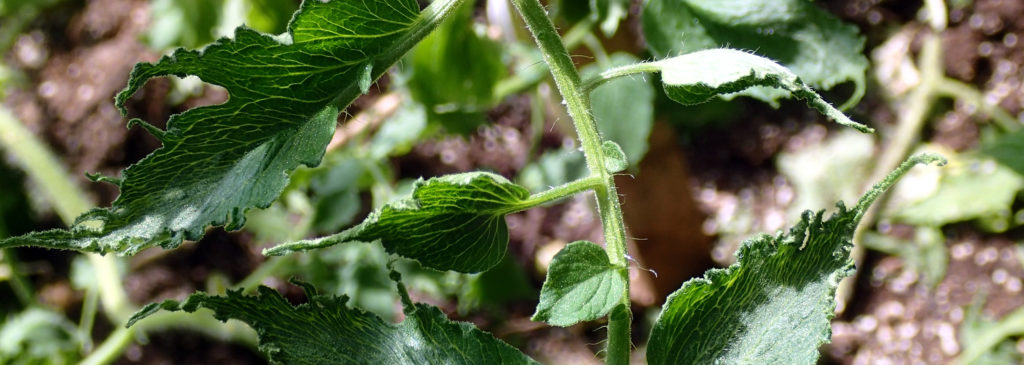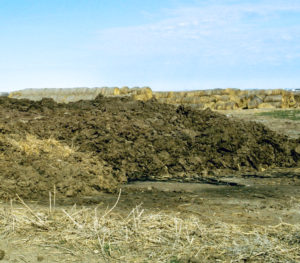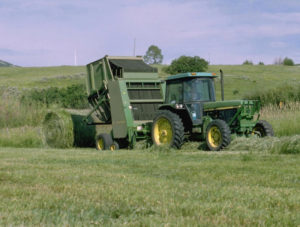
Damage to tomatoes grown in contaminated compost (Photo credit: Whitney Cranshaw, Colorado State University, Bugwood.org)
What is Herbicide Residue?
In recent weeks, the Oregon Dept of Agriculture announced the discovery of contaminated soil and compost materials from an herbicide known as clopyralid. This contaminated material was distributed to gardeners in the region causing significant damage to garden plants and landscapes. This unfortunate event helps to raise awareness of the persistence of some herbicides and the dangers of improper handling and usage of herbicide.
There is a wide range of herbicide products on the market. Some of these products can remain active long after they are applied for two reasons:
- Natural processes break down a particular herbicide very slowly.
- The herbicide does not deactivate when it comes in contact with soil particles and remains available for plants to take up through their roots.

Manure from animal feed treated with persistent herbicides needs to be carefully managed. (Photo credit: Howard F. Schwartz, Colorado State University, Bugwood.org )
Herbicides with one or both of these traits are said to have “residual activity.” Products with residual activity can provide long-lasting control of weeds compared to products that breakdown quickly or become unavailable for uptake by plants. This residual activity can be beneficial in keeping unwanted plants controlled for long periods of time, but it can also create problems if the plant material is moved to a different location. Manure, soil, hay, and compost are some of the ways that herbicides with residual activity are unwittingly moved to new places. When animals eat treated plant material the herbicide passes through the animal’s system and is concentrated in their manure. For some herbicides, this manure or compost can remain active and when spread on fields or in gardens the herbicide may damage or kill susceptible plants.
Read and Follow the Label
If you use herbicides that have residual activity it is your responsibility to prevent material containing residues from being used in a way that could damage desirable plants. Before using any herbicide read the label. The label will state how hay, manure, and compost from sprayed areas may and may not be used. The label is the law. Not following the instructions is illegal.
If you are receiving hay, manure, or compost from someone, be sure to ask them about the herbicides they use. A label comes with every container of herbicide and will clearly state if there are restrictions on hay, manure, and compost coming from treated areas. If they don’t know or won’t disclose this information don’t accept the material.

Hay producers need to be cautious using herbicides if hay is sold off-site.
(Photo credit: Howard F. Schwartz, Colorado State University, Bugwood.org )
Know Your Products
Aminopyralid, clopyralid, and picloram are three active ingredients in herbicides that can contaminate manure, hay, and compost. These ingredients are used to kill weeds in pastures, rangelands, and hayfields. The residual activity of these products is actually a selling point for these products. Because of the residual activity, producers have to apply less herbicide to achieve the same level of control. As a result, these products continue to increase in popularity and are becoming more common.
The following list includes trade names of herbicides that contain these ingredients and that have restrictions on hay, manure, and compost. Herbicide formulations and names change frequently so this list should not be considered authoritative. Always read the label before using any herbicide product.
- Aminopyralid: Milestone, Capstone, Opensight, Forefront, Grazonnext, Nativeklean, Pastur All, Chaparral, Sendero
- Clopyralid: Weld, Bite, Boomer, Colt AS, Curtail M, Full Deck, Hat Trick Three Way Herbicide, Lontrel turf and Ornamental, Quali-Pro 2-D, TruSlate Pro, Surestart, Surestart II, Agristar Commando, Stinger, Agristar Spur, Alligare Clopyralid 3, Alligare Cody, Alligare Prescott, Brazen, Clean Slate, Curtail, Definite, Hi-Yield Range and Pasture Clopyralid 3, Millennium Ultra, Perfectmatch, Primera Millennium Ultra 2 Selective, Resicore, Sendero, Sonora, Stigmata, Transline, Tritough x, Translate Selective, Whiplash, Widematch, Confront,
- Picloram: Graslan L, Trooper Extra Selective, Alligare Picloram 22K, OutPost K, Tordon 22K, Tordon K, Trooper 22K
This list was compiled from the Pesticide Information Center Online. https://picol.cahnrs.wsu.edu/
Learn More
If you are a hay producer or livestock owner managing manure on your property, take the time to educate yourself about this issue. Protect yourself from unwanted damage and liability. Learn more about persistence herbicides by following the links below.
Montana Herbicide Carryover booklet: http://www.pesticides.montana.edu/documents/references/Montana%20Herbicide%20Carryover%20Booklet%2011-2011%20LO-RES.pdf
NC State document: https://rockbridge.ext.vt.edu/content/dam/rockbridge_ext_vt_edu/files/herbicide-carryover.pdf
University of Vermont: https://www.uvm.edu/sites/default/files/Extension-Master-Gardener/PersistentHerbicidesFlyer.pdf
